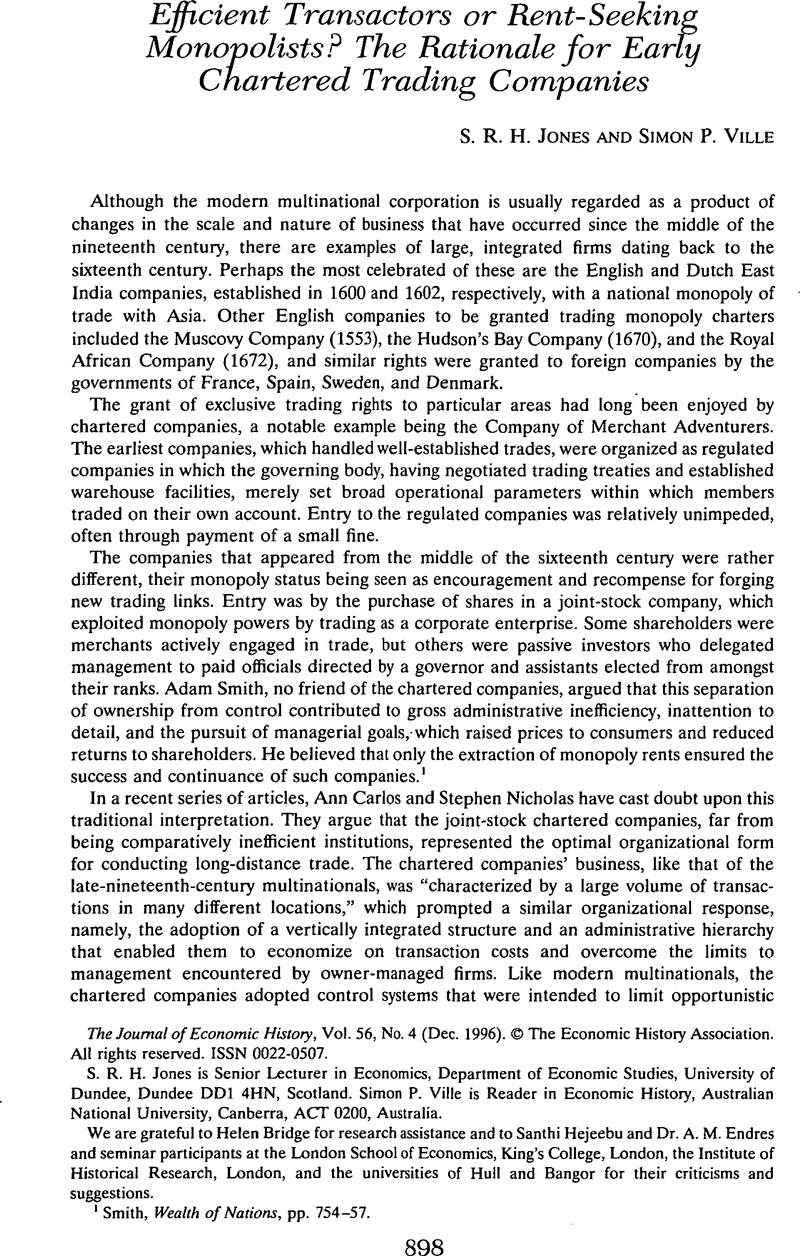Crossref Citations
This article has been cited by the following publications. This list is generated based on data provided by Crossref.
Zahedieh, Nuala
1999.
Making Mercantilism Work: London Merchants And Atlantic Trade in the Seventeenth Century.
Transactions of the Royal Historical Society,
Vol. 9,
Issue. ,
p.
143.
Stanziani, Alessandro
2000.
Information, institutions et temporalité. Quelques remarques critiques sur l’usage de la nouvelle économie de l’information en histoire.
Revue de Synthèse,
Vol. 121,
Issue. 1-2,
p.
117.
Seisreiner, Achim
2002.
Wertaneignung und Intransparenz als Koordinationsprinzipien.
German Journal of Human Resource Management: Zeitschrift für Personalforschung,
Vol. 16,
Issue. 4,
p.
525.
Carlos, Ann M.
Moyen, Nathalie
and
Hill, Jonathan
2002.
Royal African Company Share Prices during the South Sea Bubble.
Explorations in Economic History,
Vol. 39,
Issue. 1,
p.
61.
Boxall, Peter
2003.
HR strategy and competitive advantage in the service sector.
Human Resource Management Journal,
Vol. 13,
Issue. 3,
p.
5.
Kohn, Meir G.
2003.
Business Organization in Pre-Industrial Europe.
SSRN Electronic Journal,
Ellis, Paul
2003.
Are International Trade Intermediaries Catalysts in Economic Development? A New Research Agenda.
Journal of International Marketing,
Vol. 11,
Issue. 1,
p.
73.
Harris, Ron
2004.
The Formation of the East India Company as a Deal between Entrepreneurs and Outside Investors.
SSRN Electronic Journal,
Harris, Ron
2005.
The Formation of the East India Company as a Cooperation-Enhancing Institution.
SSRN Electronic Journal,
Spraakman, Gary
and
Margret, Julie
2005.
The transfer of management accounting practices from London counting houses to the British North American fur trade.
Accounting, Business & Financial History,
Vol. 15,
Issue. 2,
p.
101.
Kohn, Meir G.
2005.
Government Economic Policy in Pre-Industrial Europe.
SSRN Electronic Journal,
Austen, Ralph A.
and
Smith, Woodruff D.
2006.
The Economic Value of British Colonial Empire in the Seventeenth and Eighteenth Centuries.
History Compass,
Vol. 4,
Issue. 1,
p.
54.
Austen, Ralph A.
and
Smith, Woodruff D.
2006.
The Economic Value of British Colonial Empire in the Seventeenth and Eighteenth Centuries.
History Compass,
Vol. 4,
Issue. 1,
p.
54.
Erikson, Emily
and
Bearman, Peter
2006.
Malfeasance and the Foundations for Global Trade: The Structure of English Trade in the East Indies, 1601–1833.
American Journal of Sociology,
Vol. 112,
Issue. 1,
p.
195.
KESSLER, DAVID
and
TEMIN, PETER
2007.
The organization of the grain trade in the early Roman Empire.
The Economic History Review,
Vol. 60,
Issue. 2,
p.
313.
OGILVIE, SHEILAGH
2007.
‘Whatever is, is right’? Economic institutions in pre‐industrial Europe1.
The Economic History Review,
Vol. 60,
Issue. 4,
p.
649.
Dobija, Dorota
2008.
Emergence of Corporate Contract Set, Governance and Accountability: Standing Orders of the East India Company, 1600-1621.
SSRN Electronic Journal,
Lipton, Phillip
2009.
The Evolution of the Joint Stock Company to 1800: A Study of Institutional Change.
SSRN Electronic Journal,
Dobija, Dorota
2011.
Early Evolution of Corporate Control and Auditing: The British East India Company (1600-1643 CE).
SSRN Electronic Journal,
Seth, Vijay K.
2012.
The East India Company—A Case Study in Corporate Governance*.
Global Business Review,
Vol. 13,
Issue. 2,
p.
221.





